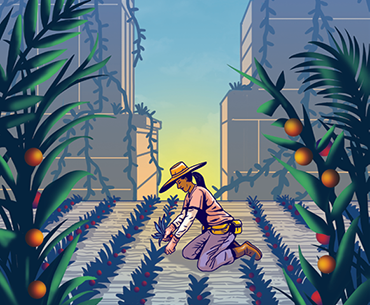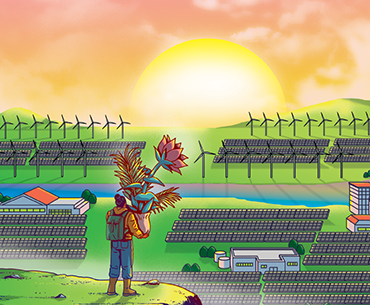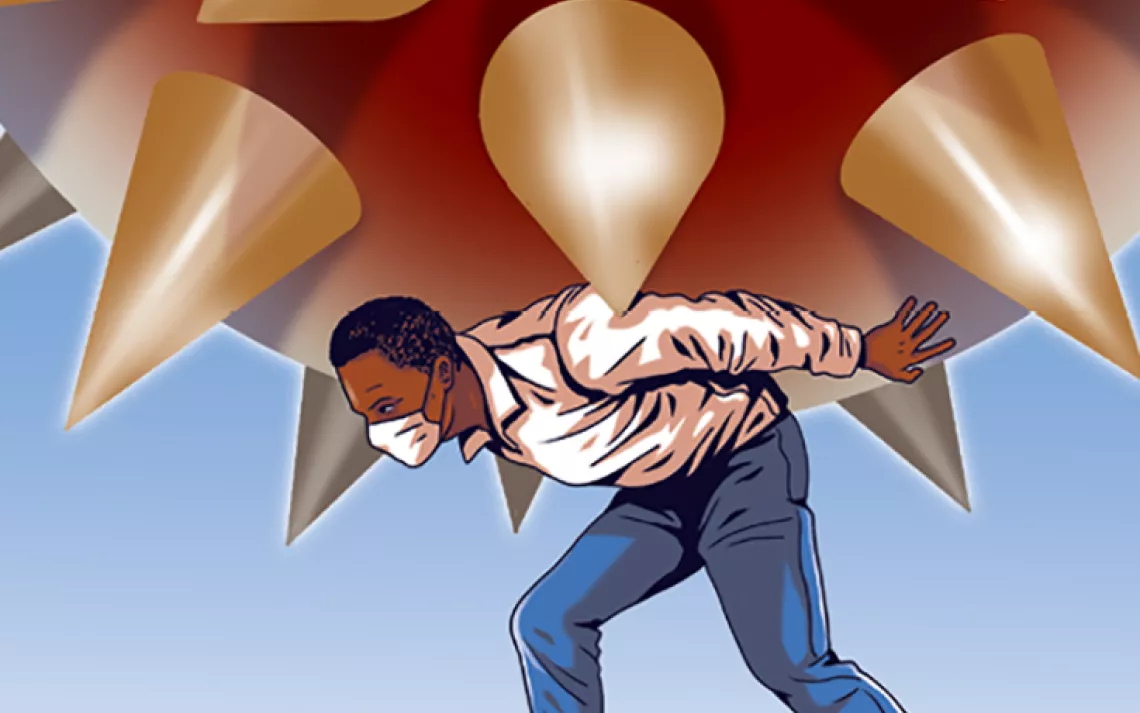Varshini Prakash on Redefining What's Possible
The Sunrise Movement cofounder shares lessons on how to grow political power
 Illustration by Glenn Harvey
Illustration by Glenn Harvey
This essay is adapted from The New Possible: Visions of Our World Beyond Crisis (Cascade Books, January 2021)
We are young people who have witnessed a world in chaos careening toward climate catastrophe. We have watched and waited our entire lives for people much older and more powerful than us to take care of the crises that were emerging. Yet little has happened. Now our generation is standing up to say, "We are ready to be the adults in the room. We are ready to take the future into our own hands. We are ready to envision reality in a different way."
A defining moment for me was December 2015, when a series of extremely strong floods deluged Tamil Nadu, the state in India that my dad (and a lot of my family) is from. It was amazing to me, looking at the images on my computer from half a world away, to be able to see the streets that I had walked on as a kid with my grandma or driven on with my grandfather in his little car. Suddenly I was seeing women and children who somehow looked very familiar to me walking waist-deep or chest-deep in water, traveling miles to sanctuary.
My grandparents were, fortunately, not in town at that time, but the water had come all the way up to their apartment floor. Hundreds of people died in that flood, and thousands were displaced. That was 2015, and it was a big wake-up call to me that the climate crisis was right now. The increase in the number and severity of flooding episodes—predicted as a result of climate change—was happening now, in the present, not in the future. That was the moment. I thought, What do I have to lose? This time it was someone else's grandmother; the next time, it could be mine. We didn't have time to waste.
That very same month, my friend Sarah and I decided we were going to start an environmental movement for young people. We needed a movement that could be powerful and could grow quickly—quick enough to respond to the climate crisis as it is worsening all around us. This was the beginning of the Sunrise Movement.
What we found when we were creating Sunrise was that there was no political home for young people in America who were concerned about the climate crisis. There was no political home for teenagers and twentysomethings who woke up every day horrified by the crisis and went to sleep imagining a chaotic, climate-disordered world. We realized that it would be absolutely game-changing if we could harness the power of young people—all their passion, optimism, and hope—and translate it into campaigns for long-lasting political change.
Young people have historically played an important role in social movements and political change. John Lewis was just a college student when he became a leader in some of the most intense protests of the civil rights movement. Then there was Diane Nash, whose youth campaigns were crucial to its success. James Lawson organized young people on campuses across the country in large part because he understood the role that young people played—in being willing to take risks and have courage, not living or being governed by the rules of yesterday. I think that's one of the most unique things about young people: We're not jaded about what is or isn't possible. We just know what needs to happen, and we work like hell to make sure that it does. That's how progress happens.
Youth movements have a particular approach to working for change, and we at Sunrise have been inspired by them. I think of four lessons in particular that we've learned from them. One of the biggest and most important principles of effective protest is this: In your demands and your vision, don't lead with what is possible in today's reality but with what is necessary—for, say, the survival of humanity, or for achieving the ultimate goals of whatever campaign or issue you're working on. So often, I find that older generations are hindered by their view of what is possible or impossible right now. The most common things I hear are "It's not practical" and "It's not realistic, considering who's in office right now," and so on. Everything that Sunrise has achieved has been under a Trump administration. If we had been led by that more pragmatic doctrine, if we had based our goals and our ambitions on the parameters of today's political possibilities, we would never have been successful.
Second, we were unafraid to go after not just Republicans—who were denying the validity of climate science and supporting misinformation campaigns—but also Democrats. We said to them, "You, too, have not done enough on this issue. You have said you believe the science. You have voted the right way. But truly, we need champions. We need fighters. We need people who are ready to stick their necks out on issues, who will fight day in and day out, who will be the leaders that we so badly need on the critical issues and talk about them from racial and economic justice perspectives." What's crucial is being willing to call for the level of action you want, no matter what your political affiliation is.
Third, storytelling is powerful. When we went into Nancy Pelosi's office [during a protest in 2018], we didn't just deliver a petition with a bunch of numbers about parts per million or 2°C. We shared stories about what we had lost because of the climate crisis, or what we were afraid of losing. We told stories about what we hoped for our future. Some of the storytellers were in high school, not even able to vote yet, but were engaged in politics because of how much they cared for their future. People told stories about what it was like to live through hurricanes and come out the other end, about the trauma these experiences instill, and about their hope that such traumas don't have to be the story for future generations.
Fourth, young people are amazing these days at using all the tools at our disposal to reach other young people, sharing our ideals not just from a political perspective but also from a cultural perspective. We powerfully marry digital organizing with offline organizing, using humor, TikTok, Instagram, and other tools. We saturate culture with our ideas, reaching people through song, art, video, and graphics. Many people have told me they joined Sunrise because they really liked our logo. We thought a lot about our logo and its meaning; we also had a designer work carefully on it and come back to us with multiple iterations. Your visuals and communication, both digitally and offline, have to communicate something significant to people.
Right now, we are seeing an expansion of what is possible. Take, for example, someone like Joe Biden, the very definition of a moderate candidate, who at the beginning of 2020 had one of the weakest climate plans among all the Democratic candidates. The pandemic hit, and then a massive uprising around racial injustice took the country and the world by storm. Biden has defined himself over his career largely as an incrementalist. Yet now, because of these huge systems-disrupting problems and the calls for transformative change, he's being forced to consider far bigger, broader, and more transformational solutions. They might actually be systems-shifting reforms. For example, his climate plan grew from a $1.7 trillion green jobs and infrastructure plan over 10 years to a $2 trillion plan over four years, with 40 percent of those investments going directly to frontline communities. It's hard to even fathom what that could do for communities of color and poor people around the nation. It's far more than any other president or president-elect has committed to on this issue.
The biggest thing that needs to happen for a better future is that ordinary people need to get more power. I don't expect power holders or people in office to make that happen. We have to build movements. In particular, we need to rebuild youth movements and the labor movement. We have to have the discipline, strategic acumen, and intellect of the fighters who came before us. And we have to grow our ranks by orders of magnitude.
The truth is that you can dream up all the white papers you want and create all the policy proposals you want, but we can't enact any of it into reality if we don't have power. That is the bottom line for me when answering almost any question about what is and isn't possible in the next few years. The road forward is uncertain. But the question of what's possible stretches us to open up our imagination and create new worlds in ways that we might never have dreamed of before.
This article appeared in the January/February edition with the headline "Teach Your Elders Well."
 The Magazine of The Sierra Club
The Magazine of The Sierra Club











